
Guests
- Angela Davisauthor, activist and professor at University of California, Santa Cruz. She grew up in Birmingham, Alabama.
Sunday marked the 50th anniversary of the bombing of the 16th Street Baptist Church in Birmingham, Alabama, a watershed moment in the civil rights movement. On Sept. 15, 1963, a dynamite blast planted by the Ku Klux Klan killed four young girls in the church: Denise McNair, age 11, and Carole Robertson, Cynthia Wesley and Addie Mae Collins, all 14 years old. Twenty other people were injured. No one was arrested for the bombings for 14 years. We hear an address by world-renowned author, activist and scholar Angela Davis, professor emerita at University of California, Santa Cruz. She spoke last night in Oakland, California, at an event organized by the Civil Rights and Restorative Justice Project at Northeastern University School of Law.
Transcript
AMY GOODMAN: Sunday marked the 50th anniversary of the bombing of the 16th Street Baptist Church in Birmingham, Alabama, a watershed moment in the civil rights movement. On September 15, 1963, a dynamite blast planted by the Ku Klux Klan killed four little girls in the church. Denise McNair was 11 years old. Carole Robertson, Cynthia Wesley and Addie Mae Collins were all 14. Twenty other people were injured. No one was arrested for the bombings for 14 years.
We turn now to world-renowned author, activist, scholar, Angela Davis, professor emerita at University of California, Santa Cruz. She spoke last night in Oakland, California, at an event organized by the Civil Rights and Restorative Justice Project at Northeastern University School of Law.
ANGELA DAVIS: And remembering and paying tribute to this tragic event, let us not pretend that we are simultaneously celebrating the end of racist violence and the triumph of democracy. Let us also not labor under the illusion that this church bombing was an anomaly. We know that Robert Chambliss, who was eventually convicted of carrying out the bombing, along with three others—we know that he had been responsible for bombing black homes and churches over so many years. As a matter of fact, during the eight years prior to the church bombing, there had been 21 bombings in Birmingham. This man’s nickname was “Dynamite Bob.” He was known in white communities, you know, talking about terrorism. And I want to emphasize the importance of understanding how much terrorism, racist terrorism, has shaped the history of this country. And there are lessons we need to learn from that.
But I’ve often pointed out that some of my very earliest childhood memories are the sounds of dynamite exploding. Homes across the street from where I grew up were bombed when they were purchased by black people who were moving into a neighborhood that had been zoned for whites. So many bombings took place in the neighborhood where I grew up—and we now know that Chambliss was probably responsible—that the neighborhood came to be called “Dynamite Hill.” And, of course, as you know, the city of Birmingham was known as “Bombingham.” In fact, on September 4th, 1963, less than two weeks before the 16th Street church bombing, the home of the leading civil rights attorney in Birmingham, Arthur Shores, was bombed. And that house was right down the street from our house.
You’ve also heard that, from Vukani Mawethu and from Margaret, that on the day of the 16th Street Baptist Church bombing, two other black youth were killed: Johnny Robinson and Virgil Ware. Bombings continued to plague black communities in Birmingham after September 15th, and everyone, including the FBI, knew who was behind them. But Robert “Dynamite Bob” Chambliss was simply charged with the possession of dynamite. And J. Edgar Hoover refused to reveal the evidence that the FBI had gathered against the perpetrators, so that there was no trial during that period.
Now, I’m not arguing that justice would have necessarily prevailed had Robert Chambliss and the others—Thomas Blanton and Bobby Cherry, Herman Cash—had they been immediately tried and convicted, although since that was the only way we had to deal with such transgressions, they should have been tried and convicted. But true justice is about transformation. Justice is about changing the relations that link us together. And as you’ve heard, the Civil Rights and Restorative Justice Project attempts to forge justice in a much deeper sense than is possible within the existing criminal justice system.
A broader way of thinking about justice in the case of the Birmingham bombing would require, first of all, a fuller understanding of the event and its historical context, and would require us to ask questions about the way our lives today bear the historical imprint of that era. What I fear is that many of the 50th anniversary observances—and there are many, as Margaret pointed out, many that have taken place, many to come—that many of them are just to close the book on the racist violence of the civil rights era so that we can embalm that violence and transform it into something to be gazed at through the conventional lens of the museum.
Maybe there’s something to be learned from the way that the Birmingham Civil Rights Institute frames that bombing, as opposed to regular museum exhibit. And if any of you have ever visited the Civil Rights Institute, you know that it is an absolutely incredible museum with amazing exhibits. But for the church bombing, there is simply a window. There is a window through which one can see the church, meditate on its history, and see it as it changes and transforms, remembering that this was the site of one of the most vicious terror attacks this country has witnessed.
If you’ve ever visited Birmingham and the museum, you will also know that across Sixth Avenue from the museum and kitty corner from the church is the Kelly Ingram Park, where demonstrations that were organized in the 16th Street Baptist Church were staged. It was the home base for the Children’s Crusade. And how many of us remember that it was young children—11, 12, 13, 14 years old, some as young as nine or 10—who faced police dogs and faced high-power water hoses and went to jail for our sake? And so, there is deep symbolism in the fact that these four young girls’ lives were consumed by that bombing. It was children who were urging us to imagine a future that would be a future of equality and justice.
It’s important that we resist the temptation of abstraction, how easy it is to think about four innocent young black girls whose lives were violently taken away by white supremacists. And I’m not suggesting that this did not happen. Of course it did. What I’m saying is that it was a lot more complicated. And if we don’t attempt to understand the complexity of this historical event, then we will certainly not be capable of comprehending that violence, that racist violence, and its connections with sexist violence or homophobic and xenophobic violence, which continues to erupt in our lives today. Resisting the temptation of historical abstraction requires us to realize that this was not an extraordinary event that erupted one Sunday morning 50 years ago in an otherwise peaceful city. As I’ve pointed out, violence was very much the norm.
When I was growing up, Bull Connor, Eugene “Bull” Connor, was the commissioner of public safety. And of course his notoriety is linked to the way in which he used those high-power water hoses and dogs against the children, and because of the KKK violence against the Freedom Riders in Birmingham, in which the police whom Bull Connor controlled did not intervene. But I remember growing up hearing—when I was growing up, I remember hearing that when black people moved into previously white neighborhoods, Bull Connor would announce that there would be bloodshed. And then, indeed, there would be a bombing, or a house would be burned.
As much talk as there has been about terrorism over the last decade, I have not heard one official acknowledgment of the terrorism that prevailed in places like Birmingham. Terrorism is a part of our history. It is not something that is alien. And, by the way, no one ever suggested that we plant dynamite in white communities as a response to that terrorism. So I guess I would say, why do we need to respond with devastating violence in Iraq and Afghanistan and Syria?
It is also not widely known that black people arm themselves. This is a story that has been excised from the official record of the freedom movement. And interestingly, Condoleezza Rice has described her minister father—this was recently in an interview with Al Sharpton—she described her minister father as being a leader of an armed patrol of black men in her neighborhood. And as she pointed out, no one was ever shot. Guns may have been fired to scare the Klu Klux Klan away. They may have been—she says they may have been fired in the air, but no one was ever shot. No one was ever hurt. And I wonder why she didn’t learn this lesson about ways to respond to terrorism, you know, which she could have used during her tenure as secretary of state. And I should say I was happy to see that this morning Melissa Harris-Perry called her out on this after showing clips of her interview with Al Sharpton.
But my father was also a member of an armed patrol in our neighborhood. Black people had guns, but only because we had no other choice. Black people had to arm themselves after the 1877 Hayes-Tilden compromise in which the Republican Rutherford Hayes was handed the presidency under the condition—remember, the Republicans were supposed to be the good guys in those days, OK—under the condition that he withdraw all federal troops from the South. And so, black people were effectively informed that they were on their own from then on, from 1877 on. This is the period that witnessed the emergence of official structures of white supremacy that did not begin to come down until the resistance of the mid-20th century freedom movement.
Just as sediments of slavery are still with us, most dramatically represented by the country’s incarceration practices and by the racism of the death penalty, the vestiges of an era where racist violence was the norm and was condoned by officials, from local governments to Washington, are still haunting us. We know the names of young black and brown people who have been killed by the police or by vigilantes. We know the names of Trayvon Martin in Florida, of Hadiya Pendleton in Chicago, who was killed shortly after having participated in the second Obama inauguration. And then, of course, here in Oakland, we know the name of Oscar Grant, Oscar Grant. And I can say that no matter how long an individual perpetrator is sent to prison in any of these cases and any others, no one can say that justice has been done, because we know that the roots of racist violence, the roots of the violence that claimed their lives, are so tightly woven into our country’s social fabric that an eye for an eye will not do it. An eye for an eye will not do it.
AMY GOODMAN: Author, activist, scholar, Angela Davis. She grew up in Birmingham, Alabama, knew two of the girls killed in the 16th Street Baptist Church bombing 50 years ago Sunday. She spoke in Oakland Sunday night at an event organized by the Civil Rights and Restorative Justice Project in Northeastern University School of Law. Special thanks to John Hamilton.

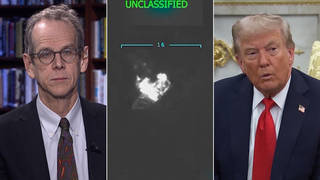

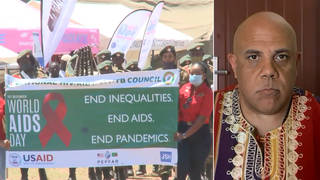
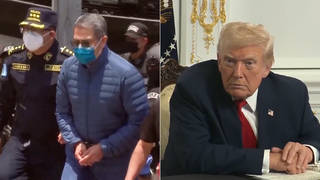





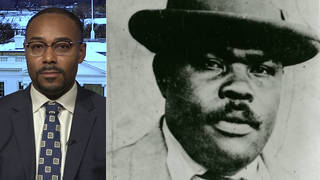
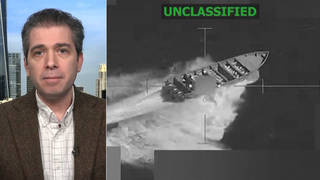
Media Options